|
Although fairly limited in size and scope, Monks and Merchants provides
a good introduction to a broad topic - the confluence of East and West along
the Silk Route in the mid-first millennium. At the same time it provides
a good entryway into the broad holdings and mission of the newly renovated
and expanded museum galleries of the Asia Society. The galleries themselves
are worth a visit. Modern and bright, the new space designed by the architect
Bartholomew Voorsanger, also manages to be warm and inviting. In addition
to several floors of new exhibition space, there is a courtyard café
and a multimedia visitors center in which “high tech” displays
are brought to life by decidedly “low tech” controls - a rock placed
on a table, for example, lights up an electronic map. These spaces are joined
by a staircase that appears to float unsupported between the four museum
levels - a mysterious road connecting the many Asian regions included in
the work of the Society, or bringing West to East, much like the Silk Road
itself.
The Monks
and Merchants exhibit covers a tumultuous period in China's history,
the four hundred years between the fall of the Han dynasty and the rise of
the T’ang empire (AD 618-906). It also focuses on a remote region of
Northwest China, including the provinces of Gansu and Ningxia, that served
during this period as the point of entry into China not only for foreign
populations, including nomads from the north as well as traders from the
west, but their cultures, languages, and ideas, including religion. Thus
what we see in these galleries are objects which reflect these new influences,
from western decorative styles to Buddhism, which mixed together with local
tradition to form a new, more worldly "Chinese" culture.
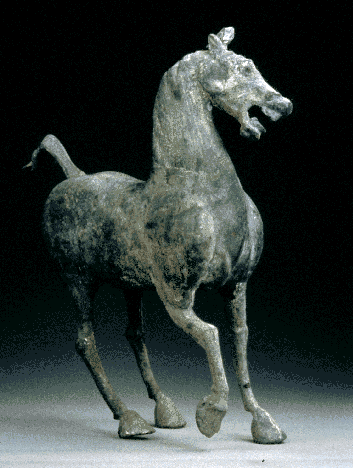 The galleries are arranged according to major themes which reflect the changing
order in Northwest China throughout the four centuries leading up to the
T’ang empire. The first of these, “Heavenly Horses and the Aftermath
of the Empire,” reflects the opening of the Silk Road at the end of
the Han dynasty, in part to acquire the superior horses of Central Asia.
A group of spirited bronze horses - one drawing a high status carriage, another
under saddle, and one unbound and prancing freely (fig.1) - found in the
tomb of a Han General reveals the esteem placed on horses in Chinese society,
as well their vital role in military campaigns to protect the Northern borders
of the empire.
The galleries are arranged according to major themes which reflect the changing
order in Northwest China throughout the four centuries leading up to the
T’ang empire. The first of these, “Heavenly Horses and the Aftermath
of the Empire,” reflects the opening of the Silk Road at the end of
the Han dynasty, in part to acquire the superior horses of Central Asia.
A group of spirited bronze horses - one drawing a high status carriage, another
under saddle, and one unbound and prancing freely (fig.1) - found in the
tomb of a Han General reveals the esteem placed on horses in Chinese society,
as well their vital role in military campaigns to protect the Northern borders
of the empire.
Fig.1:
Bronze figure of a horse, Eastern Han period, 2nd c.AD, from a tomb at Leitai,
Gansu. Ht:35cm (Gansu Provincial Museum,Lanzhou).
It is after the fall of the empire in AD 220 that China splintered into several
smaller, independent kingdoms, and the influence of non-Chinese groups began
to rise. We see early depictions of these non-Chinese peoples in scenes of
daily life (including shepherds with goats and a Bactrian camel) painted
onto bricks found in tombs of the Wei-Jan period (220-317 CE). Meanwhile,
a letter excavated in 1907 by Aurel Stein (see AR 3:1:88),
written by a Sogdian merchant currently living in the Gansu region to his
partners back home in Samarkand, the Sogdian capital over 2,000 miles to
the west. This letter, showing the sophisticated commercial interests of
these first foreign traders describes, among instructions for the transfer
of capital, various depredations by marauding Huns at the city of Luoyangs.
The next room focuses on artifacts from these early nomadic rulers, such
as the Northern Wei (386-535), and Northern Zhou (557-581), who came into
power in NW China during the 4th-64h centuries and were strongly attracted
to Buddhism. Ruling NW China during the 4th-6th centuries, both dynasties
were leading consumers of exotic goods, some used in elaborate Buddhist
offerings. Many of the objects on display here come from recently excavated
tombs. These include painted ceramic figures representing a military retinue
- musicians from a military band, armored calvarymen and foot soldiers as
well as Xianbu tribesme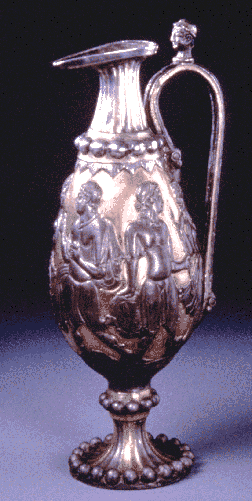 n, identified by their hooded robes and non-Chinese
facial features - that accompanied an important Northern Wei general into
death. Although it was robbed, the tomb of General Li Xian (502-564), a wealthy
nomad who was a close associate of the Northern Zhou emperor, still contained
several items which showed the great mix of cultural influences and peoples
in the region
at that time. Chief amongst these is a magnificent silver and gilt ewer imported
from ancient Bactria (Afghanistan): such silver-gilt material is distinctly
Chinese, while the form of the ewer itself is from Persia, and the fluted
and beaded decorative work on its surface are Late Antique and Central Asian
in origin, respectively. Moreover, the figures in low relief depict the Classical
Greek myth of the Trojan War, but have the tight-wasted forms and flowing
posture more familiar in eastern art (fig.2). n, identified by their hooded robes and non-Chinese
facial features - that accompanied an important Northern Wei general into
death. Although it was robbed, the tomb of General Li Xian (502-564), a wealthy
nomad who was a close associate of the Northern Zhou emperor, still contained
several items which showed the great mix of cultural influences and peoples
in the region
at that time. Chief amongst these is a magnificent silver and gilt ewer imported
from ancient Bactria (Afghanistan): such silver-gilt material is distinctly
Chinese, while the form of the ewer itself is from Persia, and the fluted
and beaded decorative work on its surface are Late Antique and Central Asian
in origin, respectively. Moreover, the figures in low relief depict the Classical
Greek myth of the Trojan War, but have the tight-wasted forms and flowing
posture more familiar in eastern art (fig.2).
Fig.2: Silver gilt ewer from Tokharistan or Bactria, 5th-6th c. AD.
Excavated from the tomb of Li Xian (d.569), in Guyuan, Ningxia . Ht: 37.5
cm (Guyuan Municipal Museum).
Besides importing new art styles and goods, these rulers also became influential
patrons of Buddhism. Buddhism was brought to China by monks, who carried
scriptures and relics and established shrines along the Silk Route as they
moved eastward from India and Central Asia. Since the religion encouraged
the making of holy images, the new Chinese converts were quick to patronize
the creation of new cave temples, pagodas, statues and texts. Several such
sculptures are arranged 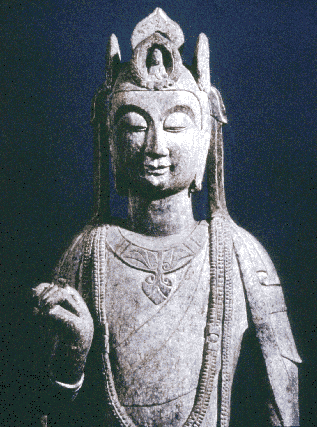 together in a gallery indicative of one of these
cave shrines; an actual, well-preserved shrine at the elaborate, cliff-hewn
monastery of Dunhaung can be seen in an accompanying video. The Buddha is
easily identified in these sculptures - he is shown wearing unadorned monastic
robes, representing his disavowal of earthly ties, and often appears with
his disciples. Other figures are of bodhisattvas, beings who have obtained
enlightenment yet remain on earth in order to help others reach Nirvana,
who are more richly arrayed, often with long hair, a crown and hold a lotus
or other symbolic object. The central piece in this collection is an unusual,
graceful, granite sculpture of the Bodhisattva Avalokitesvara (Chinese Guanyin),
the popular protector of travelers and others in need of help (fig.3). together in a gallery indicative of one of these
cave shrines; an actual, well-preserved shrine at the elaborate, cliff-hewn
monastery of Dunhaung can be seen in an accompanying video. The Buddha is
easily identified in these sculptures - he is shown wearing unadorned monastic
robes, representing his disavowal of earthly ties, and often appears with
his disciples. Other figures are of bodhisattvas, beings who have obtained
enlightenment yet remain on earth in order to help others reach Nirvana,
who are more richly arrayed, often with long hair, a crown and hold a lotus
or other symbolic object. The central piece in this collection is an unusual,
graceful, granite sculpture of the Bodhisattva Avalokitesvara (Chinese Guanyin),
the popular protector of travelers and others in need of help (fig.3).
Fig.3: Granite figure of Avalokitesvara, the Bodhisattva of Compassion,
from Qinan District, Gansu Province; Sui Dynaty (AD 608-618). Ht: 144 cm
(Gansu Provincial Museum).
Two very different sculptures show the disciple Kasyapa. T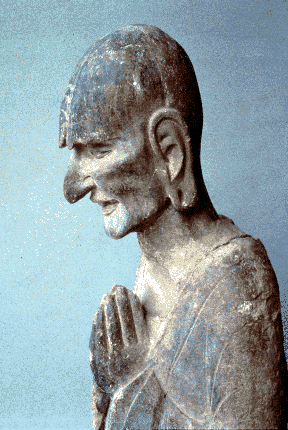 he oldest of the
Buddha's followers, he is depicted in an earlier clay work (AD 535-557) with
a Chinese caricature of “western” facial features. This includes
a prominent nose, deep high cheekbones, heavy, drooping brows, and oversized
ears (fig.4), with the long or beaked nose the main stereotyped facial feature
used by Chinese artists to illustrate such “foreignness.” In the
later T’ang work, only a slight furrowing of the brow, and open, wise
expression identify the older man, this time more Chinese in appearance (fig.5). he oldest of the
Buddha's followers, he is depicted in an earlier clay work (AD 535-557) with
a Chinese caricature of “western” facial features. This includes
a prominent nose, deep high cheekbones, heavy, drooping brows, and oversized
ears (fig.4), with the long or beaked nose the main stereotyped facial feature
used by Chinese artists to illustrate such “foreignness.” In the
later T’ang work, only a slight furrowing of the brow, and open, wise
expression identify the older man, this time more Chinese in appearance (fig.5).
Fig.4: Clay figure of Kasyapa, Western Wei period (AD 535-557),
from Maijishan Cave 87 in southern Gansu. Ht: 140 cm (Maijishan Research
Inst.).
Several works
illustrate the lives of the Sogdian people, immigrants from Transoxiana (modern
Uzbekistan and Tajikistan) who came as merchants and soon s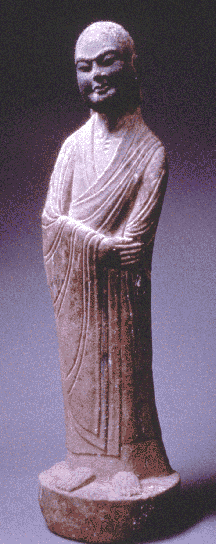 erved as officials
in the Chinese courts. Although largely assimilated into Chinese society,
they kept many distinct aspects of their culture, including their Zoroastrian
religion - the local Chinese were fascinated by the whirling “Sogdian
dance” of religious ecstasy, as depicted on one tomb door. A small area
of the exhibit has been set aside for burial objects of the Shi Clan who
settled in Yuanzhuo (Guyuan). The most striking of these is a gold mask,
once sewn onto cloth; in addition to the use of gold, the central “crescent
and sun” crown motif appears to reflect origins further west, in Central
Asia and Iran. The same crescent and sun motif (later appropriated by Islamic
states) can be seen on Sasanian coins of 6th century rulers Khusru I and
II shown at the exhibit. These silver Sasanian drachmae were used as
international currency on the Silk Road, along with Byzantine gold solidi
(later, counterfeited), even more than were the square-punched Chinese coins,
whose value was mainly recognized only within China. erved as officials
in the Chinese courts. Although largely assimilated into Chinese society,
they kept many distinct aspects of their culture, including their Zoroastrian
religion - the local Chinese were fascinated by the whirling “Sogdian
dance” of religious ecstasy, as depicted on one tomb door. A small area
of the exhibit has been set aside for burial objects of the Shi Clan who
settled in Yuanzhuo (Guyuan). The most striking of these is a gold mask,
once sewn onto cloth; in addition to the use of gold, the central “crescent
and sun” crown motif appears to reflect origins further west, in Central
Asia and Iran. The same crescent and sun motif (later appropriated by Islamic
states) can be seen on Sasanian coins of 6th century rulers Khusru I and
II shown at the exhibit. These silver Sasanian drachmae were used as
international currency on the Silk Road, along with Byzantine gold solidi
(later, counterfeited), even more than were the square-punched Chinese coins,
whose value was mainly recognized only within China.
Fig.5: Sandstone figure of Kasyapa, Tang Dynasty (AD
618-906), from Binglingsi Cave 10 in Gansu. Ht: 75 cm (Binglingsi
Research Inst.).
The exhibit ends with artifacts of the Tang Dynasty (618-906), a time when
various foreign influences came together to form a pinnacle of
achievement in China, as well as the peak in trade along the Silk Route.
Demonstrating this cosmopolitan era of assimilation are objects which show
clear inspiration from other regions: silvered mirrors with grapevine motifs
echo the first imported wine in the region, and are accompanied by depictions
of lions, another exotic import, while a lead-glazed ceramic ewer with a
phoenix head recalls the Sasanian metal ewer. Found inside a set of nested
boxes - the largest one of stone, the next of gilded bronze, a slightly smaller,
coffin-shaped box in silver, and the sm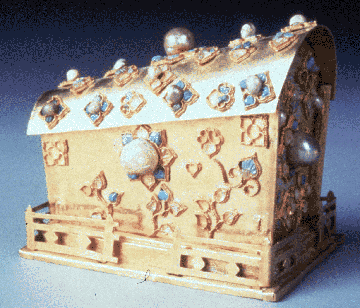 allest of worked gold covered in
semi-precious stones (fig.6) - was a tiny glass bottle containing 14 grains.
These are said to be the remains of the Buddha, placed into 84,000 different
caskets by an Indian King and distributed throughout Buddhist lands for worship. allest of worked gold covered in
semi-precious stones (fig.6) - was a tiny glass bottle containing 14 grains.
These are said to be the remains of the Buddha, placed into 84,000 different
caskets by an Indian King and distributed throughout Buddhist lands for worship.
Fig.6: Gold reliquary in the form of a miniature coffin, Tang Dynasty,
from Dayun Temple, Jingchuan County, Gansu. Length: 12.3 cm (Gansu Provincial
Museum).
The curators of this exhibit - Annette L. Juliano of Rutgers University,
Judith A. Lerner, and Colin Mackenzie of the Asia Society - are to be thanked
for bringing these fascinating and little seen artifacts to our attention.
All recently excavated, and thus -unlike most exhibits dealing with ancient
objects - all of secure, known provenience, they provide a solid education
into an important era of Chinese history. Like myself, many who view this
exhibit will likely find themselves adding Northwest China to their wishlist
of places to visit in the near future. Similarly, Vishakha N. Desai, Director
of Asia Society Museum and Cultural Programs, deserves commendation for expanding
the institution into a first-class museum, and providing an important center
for Americans to learn more about Asian history and society.
Reviewed by Michele A. Miller
This article appears on pp. 76-77 in the Museum Reviews section of Vol.3, No.2 of Athena
Review.
.
|
|